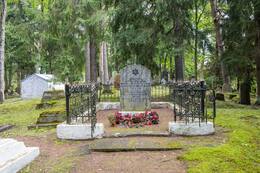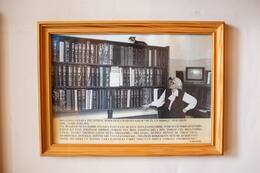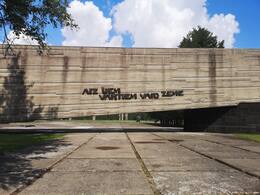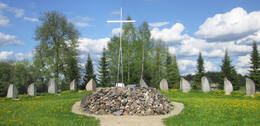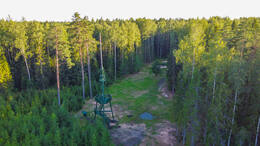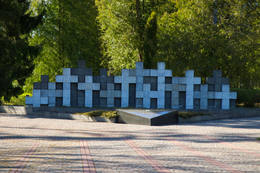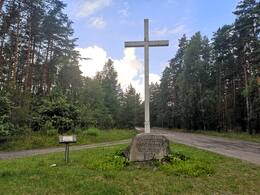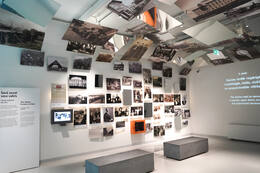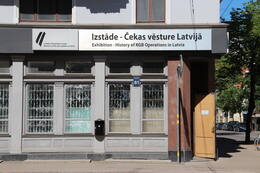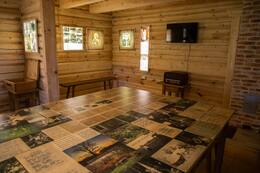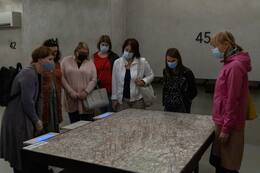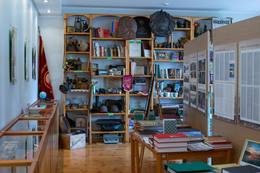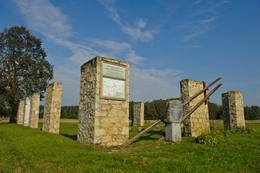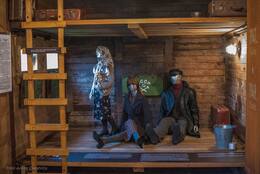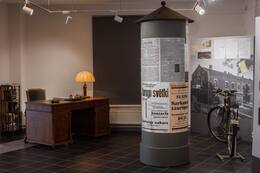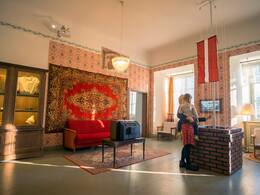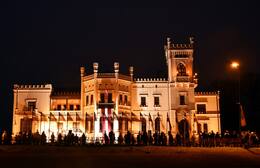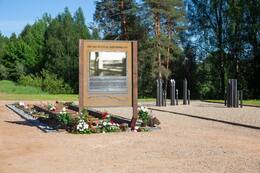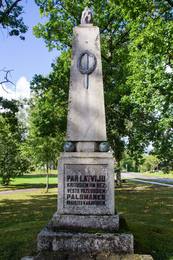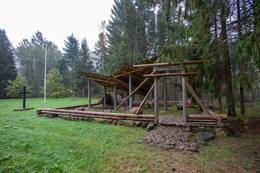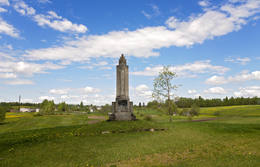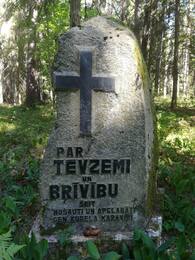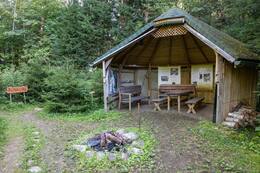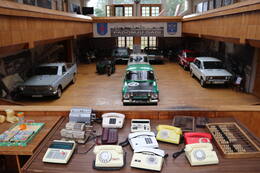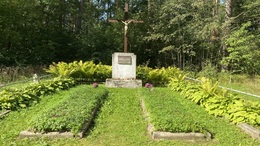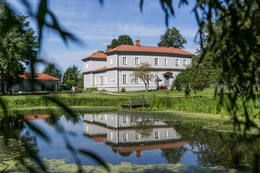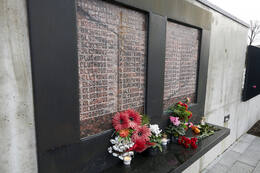Repression II WW2, IV Soviet Occupation
Repression - Persecution, oppression and restriction of certain individuals and populations by the authorities. Violent repression against the people of Latvia characterizes the occupation regimes of both the USSR and Nazi Germany.
In order to prevent resistance and dissatisfaction with the new regime, already in the summer of 1940 the Soviet occupation authorities began to carry out systematic repression against Latvian citizens by repressive organizations of the USSR NKVD (People's Commissariat of Internal Affairs) and structures modeled on the ground. For political reasons, 1940-1941. More than 7,000 Latvians were arrested in 2006, excluding deportees. The biggest repressive action was the deportation on June 14, 1941, during which 15,424 people were deported to the USSR from Latvia. The detainees were sent to GULAG correctional camps, while the administrative deportees were sent to Siberian collective farms.
In the summer of 1941, the territory of Latvia came under the rule of Nazi Germany, whose occupation regime was no less brutal than that of the Soviets. The biggest crime committed by Nazi Germany in the territory of Latvia was genocide against Jews or the Holocaust. Due to Hitler's racist ideology, almost the entire hundred-year-old Latvian Jewish community was systematically exterminated - about 70,000 Jews and about 20,000 more from other parts of Eastern Europe. The shootings of Jews were mostly carried out as early as 1941. The German occupation regime also turned against the regime's political opponents and Soviet activists who had failed to evacuate Russia at the beginning of the USSR-German war.
From 1944, the Soviet occupation power was located and restored in the territory of Latvia. The second Soviet occupation brought new political repression. In the first years after the war, there was an active national resistance movement in Latvia, or national partisans. Their goal was to restore Latvia's independence. 20th century In the 1940s, mass arrests of members of the resistance movement and their supporters took place, and Latvians who had voluntarily or forcibly cooperated with the German occupation regime and other groups were also punished. 1944-1945 Around 38,000 people were arrested in. The biggest punishment carried out during the Soviet occupation after World War II was the deportation on March 25, 1949. During that time, 42,195 Latvians, mostly women and children, were deported from Latvia to Siberia and other remote areas of the USSR. It is estimated that during the first Soviet occupation in 1940-1941. Between 1945 and 1903, between 140 and 190,000 people were killed or killed in Soviet repression in Latvia.
Fear of the return of the Soviet occupation regime in 1944, the movement of refugees from Latvia to the West by sea and land also began.
More information sources
Repression of totalitarian occupation regimes against the population of Latvia. 1940-1953 Latvian National Museum of History: http://lnvm.lv/?page_id=3976
Totalitarian occupation regimes in Latvia in 1940-1964. Research of the Commission of Latvian Historians. Articles of the Commission of Latvian Historians. Volume 13. Riga, 2004. https://www.president.lv/storage/kcfinder/files/item_1618_Vesturnieku_komisijas_raksti_13_sejums.pdf
Related timeline
Related objects
Varaklani Jewish Cemetery - a memorial to the victims of German-fascist terror
Varakļāni Jewish Cemetery, at the end of Kapsētas Street.
There are two monuments erected in the Varakļāni Jewish cemetery after the war by surviving relatives and relatives.
One of them is located near the cemetery fence, where the mass extermination of Jews took place. The inscription on it in Russian and Yiddish reads: "We will mourn forever with our parents, brothers and sisters who died at the hands of the fascists in 1941." The second monument is inside the cemetery; In the place where the killed Jews were later reburied, there is also an inscription in Yiddish and Russian: "Eternal memory of the victims of the German-fascist terror - the Jews of Varakļāni, brutally killed on August 4, 1941".
Nazi German troops entered Varaklani in 1941. In early July, and from the very first days, the siege and isolated killings of Jews began. A conditional ghetto was established near the Jewish cemetery, to which all Jews had to move. On August 4, a German SD unit (the "Arāja team") shot virtually all Jews in Varakļāni (about 540 people) with the help of local self-defense forces on the territory of the Jewish cemetery.
Every year on the first Sunday of August, a memorial event dedicated to the Jews killed in Varakļāni takes place in the Varakļāni Jewish Cemetery.
Museum of Melānija Vanaga and Siberian dugout
The Melānija Vanaga Museum is located in the Amata village school in Cēsis municipality. The museum showcases materials about the life, literary activity, family and destiny of writer and cultural historian Melānija Vanaga: video content about Siberia and the deported Latvians living there and a Siberian dugout taking its visitors on a trip to the writer’s place of deportation in Tyukhtetsky district, Krasnoyarsk region. The appearance and layout of the dugout form a realistic idea of life away from home. The dugout features unique historical objects brought there from the Tyukhtet Museum: a birch-bark dish known as ‘tuyesok’, a clay mug known as ‘krynka’ and a kerosene lamp. The museum features video interviews with politically repressed people from the municipality and 18 characters from Melānija Vanaga’s book Suddenly, a Criminal: Sixteen Years in Siberia. The museum’s virtual exhibition ‘BE YOURSELF!’ (http://esipats.lv) shows the experiences of five deported children and their parents who were wrongly accused by the Soviet authorities of ‘betrayal of the motherland’.
Salaspils Memorial Ensemble
Salaspils Memorial and historical exhibit is located in Salaspils municipality, 1.2 km from the Riga-Daugavpils A6 highway. The Salaspils Memorial was unveiled in 1967 on the site where during World War II the Salaspils Camp was once located. It is a place that was used for Soviet propaganda and is shrouded in myths and half-truths. It is a good representation of the Nazi crimes and Communist ideology that was carried out during each of the occupations. This repressive camp was a part of the German penitentiary system. It had similarities with concentration camps, but it was not the same thing. It was created so that there would not be a disproportionate number of prisoners in Riga prisons. This camp was an “extension of the police prison”. And a variety of people were imprisoned here – Jews, the Red Army prisoners of war, absentees, political prisoners, criminals, prostitutes, members of the Latvian resistance movement, Baltic soldiers in the German Army or police, and others. The camp could hold up to 2,200 prisoners. The main cause of death (~2000) was malnutrition, working conditions, corporal punishment and illness.
Memorial to victims of communist genocide
This memorial is situated in Pilistvere cemetery.
Groundwork for the memorial began in 1988, with 300 people rallying to the cause. The joint effort of volunteers continues to this day, with improvements being made to the memorial each year. The idea for the memorial came from freedom fighter Lagle Parek.
At its centre lies a cairn of rocks brought from places over Estonia, from Siberia and from even further afield by Estonian expats. The cairn is crowned by a large cross. The foot of the cross is a symbolic tomb, to which Estonian people bring rocks to commemorate loved ones deported to Siberia.
The cairn is surrounded by boulders, one for each county, designed by Aate-Heli Õun and set in place in phases.
Near the memorial are memorial stones to the victims of the radiation from Chernobyl, to the Forest Brothers, to those conscripted into the NKVD’s labour columns, to Estonian volunteers in the Finnish army and to freedom fighters. These were all designed by Endel Palmiste.
In addition to the cairn, a grove of more than 2000 memorial trees has been planted near the memorial. The grove was designed by renowned landscape architect Andres Levald.
The historic Pilistvere pastorate, serving as the main building at the memorial site, houses an archive and an Estonian History Museum exhibition about the occupation of Estonia.
Latvian Army Summer Camp in Litene
The Latvian Army Summer Camp in Litene is located in the forest in Litene parish, near the Pededze River. The beginnings of the Litene Camp can be traced back to 1935 when the construction of a summer camp complex for the Latgale division of the Latvian Army was started. From May to autumn, several thousand soldiers learned combat tactics and shooting skills in Litene. In the summer of 1941, Latvian Army officers were arrested by Red Army and NKVD troops at an army summer camp in Litene. Several officers were shot on the spot, while others were deported to Siberia. On 14 June 1941, at least 430 officers were arrested and deported to Siberia in the Litene and Ostrovieši camps about 10 kilometres from Litene. The only historical building that has survived from the camp is a food storage facility. Only the foundations remain from the other buildings. There is a viewing platform with the Latvian flag, benches and a well-maintained place for a fire. A demilitarised cannon was installed with the support of the Ministry of Defence and the National Armed Forces. Information boards are in place. The Wall of Pain memorial in the Litene graveyard is also connected with the events at the Litene camp. The YouTube channel of the Latvian Army features a video named ‘Litene, Katyn of the Latvian Army’.
Memorial Wall of Pain
Artrodas Litene cemetery.
On June 14, 2001, the memorial “Wall of Pain” created by architects Dina Grūbe, Benita and Dainis Bērziņš, stonemasons Ivars Feldbergs and Sandra Skribnovskis was unveiled in Litene Cemetery, it symbolizes the resting place of the soldiers killed in 1941. In October 1988, the ashes of 11 officers killed in June 1941 by the Soviet Army were found in the territory of the former Latvian Army summer camp in Sita Silila, Litene Parish. Although they could not be identified, on December 2, 1989, at the consecration service in Gulbene Evangelical Lutheran Church, Litene Cemetery was solemnly reburied.
11 white crosses, memorial plaque and information stands.
Memorial "White cross" in Stopiņi
Located in the forest 50 m from the highway V36, in the section from the village of Jugla paper factory to the highway P4.
Between February 3 and March 25, 1941, the remains of 23 people were described in four pits at the site. The victims were shot in a check building in Riga. The exhumation took place on April 27, 1944. At that time, 14 burials were identified, today, as a result of research, all those buried in this place have been identified.
The White Cross was erected at the site on July 12, 1991, as a memorial to the victims of the communist occupation. The White Cross was made and installed by the folk fronts and residents of Stopiņi County. In 1998, a memorial stone made by the sculptor Uldis Stergs with the inscription "Victims of the Russian Empire in 1941" was erected near the White Cross.
Buried here: Jānis Bergmanis (1900-1941), Alberts Bļodnieks (1904-1941), Kārlis Goppers (1876-1941), Arveds Laane (1916-1941), Ernests Ošs-Oše (1882-1941), Antons Pacevičs (1901 -1941), Joseph Poseiko (1897-1941), Arnold Smala (1912-1941), Joseph Stoller (1903-1941), Valfrid Vanx (1888-1941), Zenon Vyaches (1904-1941), Viktor Kopilov (1904-1941) ), Kārlis Prauls (1895-1941), Artūrs Salnājs (1904-1941), Jevgenijs Simonovs (1896-1941), Eduards-Verners Anerauds (1897-1941), Ephraim Gorons (1910-1941), Pēteris Ļaksa-Timinskis (1913 -1941), Pēteris Melbārdis (1892-1941), Israel Paļickis (1911-1941), Jānis Priedītis (1897-1941), Jānis-Arnolds Stālmanis (1913-1941), Aleksandrs Veinbergs (1884-1941).
Museum of the Occupation of Latvia
The museum exhibits the history of Latvia from 1940 to 1991, under the occupation of Nazi Germany and the Soviet Union. ‘House of the Future’ is a reconstruction and expansion project of the Occupation Museum designed by the well-known American Latvian architect Gunārs Birkerts as well as the new exhibit of the museum. The exhibit ‘History of Cheka in Latvia’ was created by the Occupation Museum and it is located in the ‘Corner House’, which is the former USSR State Security Committee (KGB) building. Latvian Occupation Museum was founded in 1993. It tells the long-hidden story of the fate of the Latvian state, nation and land under the occupation of two foreign totalitarian powers from 1940 to 1991. At the end of 2020 the museum had more than 70,000 different historical items (documents, photographs, written, oral and material evidence, objects and memorabilia). Museum specialists have recorded more than 2,400 video testimonials, making it one of the largest collections on occupation in Europe. The events that unfolded in Latvia, Lithuania and Estonia clearly show us what the nations had to endure under the two totalitarian regimes.
Exhibition in the KGB Building "History of KGB Operations in Latvia"
The former USSR State Security Committee (commonly known as Cheka) building is open for visitors. Here chekists imprisoned, interrogated and murdered Latvian citizens who were considered opponents by the occupation regime. There is also an exhibit from the Latvian Occupation Museum on the activities of Cheka in Latvia. Guided tours of the prison cells, corridors, basement and courtyard are available. The house was built in 1911 and it is one of the most beautiful buildings in Riga. Called the ‘Corner House’ by the people, it was the scariest symbol of the Soviet occupation regime in Latvia, and also one of the pillars of power of the USSR. Cheka operated from the Corner House during the occupation from 1940 to 1941 and then again from 1945 to 1991. Tens of thousands of Latvians were affected by direct political persecution. The fight against enemies of Soviet rule continued also after World War II. Cheka’s approach towards its operation slightly changed after Stalin’s death. Physical torture was replaced by psychological terror. The majority of Cheka agents were Latvians (52%). Russians were the second largest group – 23.7%. 60.3% of the agents were not members of the Communist Party. 26.9% of the agents had higher education. The system was designed in a way to involve local people and thus have greater control over the society. Staff documents and service records are located in Russia. And these materials have not been made available to Latvian authorities and researchers.
Broņislava Martuževa poetry barn
The Broņislava Martuževa Museum is situated on the site of the poet’s childhood home in Indrāni parish, Madona municipality. The museum’s exhibit is located in a renovated barn featuring voice and video evidence from the National Resistance Movement and the work of the poet in publishing an underground magazine, as well as composing poetry and songs for national partisans. Broņislava Martuževa was involved with the resistance movement since its inception. Lazdiņas, Martuževa’s home which has not survived, also served as a place of refuge for Pēteris Supe, Head of the Latvian National Partisan Association, and his comrades-in-arms. The poet spent five years hiding in the basement of her home, meeting with partisans, writing poetry (including work dedicated to partisans Pēteris Supe, Vilis Toms, Smilga Group, Laivenieks, Salns, Celmiņš, Bruno Dundurs and others), as well as writing songs and teaching them to partisans. Now, her songs are sung by the ‘Baltie lāči’ group (literally: ‘White Bears’). In 1950, the ‘Dzimtene’ magazine (literally: ‘Motherland’) was published underground together with Vilis Toms. The poet transcribed 11 issues of the magazine, 10 copies each, by hand. The poet, her brother, sister, mother and Vilis Toms were arrested in 1951. Bronislava Martuževa returned from Siberia in 1956. Recognised locally and nationally, the poetry barn is visited by both local residents and guests of the municipality. Learning about the poet’s life gives you the opportunity to discover the fate of Latvia.
Historical Exposition “The Burning Conscience”
The historical exhibit ‘Fire of Conscience’ is located in Cēsis, near the Cēsis Castle Square. Established in a Soviet-era temporary detention facility, it tells about the occupation of Latvia and reveals surprising and heroic stories of resistance from individuals. The yard features a memorial wall with the names of 643 residents of the former Cēsis district who died in Soviet repressions, including national partisans deported in 1941 and 1949 and those shot and sentenced to death. The exhibit’s timeline encourages visitors to study the course of the occupation of Latvia from 1939 to 1957. Arranged by topics, quotes from local newspapers offer a comparison of the political propaganda of the two occupation regimes. The six cells for temporary detention have survived to the present day in their original form from 1940 to 1941 and the post-war years. Here, the residents of Cēsis district, detained for various anti-Soviet activities, including national partisans, their supporters, young people who distributed anti-Soviet leaflets and other ‘traitors of the motherland’, were held for several days during the initial investigation and interrogation before being sent to the main KGB Building in Riga. Everything here is real: cells with iron doors, built-in ‘kormushkas’ (small openings for providing food), plank beds, a latrine for detainees, a small kitchen with an oven, as well as typical Soviet-era oil paint on the walls. In 2019, the exhibit was ranked third in the national design competition, the Latvian Design of the Year Award.
Permanent exposition of local history of Vaidava parish
Located in Vaidava Culture and Craft Center.
There is an exposition dedicated to the memory of the deportations of 1949, as well as the participation of the people of Riga in the January 1991 barricades in Riga. Evidence of world wars (mainly printed materials) can also be seen in the exhibition.
Natural and historical objects, manors, history of education, culture, notable people, materials of the collective farm time, household items, banknotes, newspapers, magazines about Vaidava parish.
Memorial to the Victims of Communist Terror for the Repressed in Jaunrauna Parish
Located in "Baižēni", Priekuli parish
A memorial place for the repressed was created in the place of the ruins of the barn of the "Baižēni" house, where on the night of March 25, 1949, 40 residents of Jaunrauna parish were kept to take their way to Lode railway station and Siberia in the morning.
The repressed included children under 1 year of age and 87-year-olds.
The names of those who were shot or died in exile are also written on the memorial plaque. Next to it are memorial stones to the Knights of the Lāčplēsis War Order.
Cattle wagon used for deportations – museum at Skrunda train station
To commemorate the deportations of June 1941 and March 1949, a memorial stone and a four-axle wagon, which also serves as the museum dedicated to deportations, was erected at the Skrunda railway station. This is the first wagon-type museum in Latvia that holds a permanent exhibit of photos, letters, memoirs, documents and various items made by the people deported from the Skrunda station. Skrunda station was a location where deportees were gathered, and one of the three stations in the region to which people from the Skrunda and the Kuldīga area were brought. In 1941, the family of the first President of the restored Republic of Latvia, Guntis Ulmanis, was deported from here to Krasnoyarsk Krai in Siberia.
With the help of deportations, the Soviets dealt with supporters of the national partizans’ and at the same time intimidated the remaining rural population, forcing them to join the collective farms.
Exposition "Latvian Army in Pļaviņas in the 20th Century"
Located at Odzienas Street 2, Pļaviņas.
The permanent exposition "Latvian Army in Pļaviņas in the 20th Century" can be seen.
The building in Pļaviņas, Odzienas Street 2, has a long history - from the time when Stukmaņi wholesaler Hugo Apeltofts started active economic activity in it, thus promoting the development of Pļaviņas city, until the headquarters of the Latvian Eastern Front was established here during the War of Independence. In 1919, the activities of Latvian army units against the Red Army in Latgale were commanded directly from Pļaviņas.
In 1934, a memorial plaque was unveiled near this house with the inscription: "In 1919, the headquarters of the Eastern Front was located in this house, and here General Jānis Balodis took over the command of the Latvian National Army." It was removed and destroyed by the Soviets in 1940, but on June 16, 1990, with the support of the LNNK Plavinas branch, it was restored.
Now, next to the former headquarters building, there is a memorial stall dedicated to 15 cavalry of the Lāčplēsis Military Order born in Pļaviņas region. In Pļaviņas, as well as provides an insight into the life stories of the Knights of the Lāčplēsis War Order.
Not far from the exposition building is the Latgale Division headquarters building, which was built in 1913 by Count Teodors Medems as a Stukmaņi liqueur factory. In 1919 it was taken over by the regime of P. Stučka, where it had also established a prison. After the expulsion of the Bolsheviks, in 1925 the building was taken over by the Latvian Army, which housed the headquarters of the Latgale Division. 10 generals and other officers of the Latvian Army spent their military careers in this building. In 1940, the building was taken over by the Red Army. In the post-war years, it housed a school as well as a municipality. Around 1970, the building was started to be used by the production association "Rīgas Apīrsbs".
Visits to the exhibition must be booked in advance by calling T. 28442692.
Exhibition "Struggles for freedom in the 20th century" in Jēkabpils History Museum
Located in Krustpils Palace
Viewable exhibition "Fights for freedom in the 20th century"
Soviet repression. Hard memories. Sitting here in a club chair, you can listen to fragments of the book "Those were the times" by Ilmars Knaģ from Jēkabpils. On one of the walls of the room, a list of townspeople deported to Siberia slides dispassionately, like the credits after a movie. There you can watch an amateur video about the removal of the Lenin monument in Jēkabpils on the old TV. Visitors are interested not only in the content, but also in the technical possibilities - how did this film get on the old TV.
It is possible to listen to the lectures prepared by the museum specialists at the Jēkabpils History Museum or apply for an excursion: Jēkabpils and its surroundings in the First World War, Jēkabpils in 1990, the time of the Barricades, the deportations of 1949 - 70, Jēkabpilians Cavaliers of the Lāčplēš Military Order, etc.
The average duration of lectures is 40 min. Information and registration for lectures by calling 65221042, 27008136.
Jēkabpils History Museum is located in Krustpils Castle. In 1940, after the inclusion of Latvia in the USSR, the 126th Rifle Division was stationed in Krustpils Castle. During the Second World War, the castle housed a German infirmary, and after August 1944, a Red Army war hospital. After the war, Krustpils Castle with the adjacent manor buildings were occupied by the central warehouses of the 16th Long-range Reconnaissance Aviation Regiment and the 15th Air Army of the Soviet Army.
Alūksne Museum
The Alūksne Museum is located in an architectural monument of national significance: the neo-Gothic Alūksne New Castle built in the late 19th century. The museum features an exhibition named ‘Memorial Room for Victims of the Totalitarian Regime’, which tells about the fate of the inhabitants of Alūksne municipality in Siberia and the Far East, while the time periods from prehistory to the present meet in the Alūksne history exhibit ‘Feast of the Ages’. It features a separate section devoted to the contribution of the 7th Sigulda Infantry Regiment to the military, culture and public life. The formation of the 7th Sigulda Infantry Regiment began on 20 June 1919 in the Naukšēni Manor. Initially, a battle group of 22 officers and 1,580 soldiers was formed from the reserve battalion of the Northern Latvian Brigade, and was named the Dankers Division. It was included in the 2nd Battalion of the 3rd Jelgava Regiment. On 23 August, following an increase in the number of companies, it became part of the 7th Sigulda Infantry Regiment. Having taken part in the battles against Bermondt, on 5 January 1920, the regiment was transferred to the Latgale front to fight the Bolsheviks. After the signing of the Peace Treaty with Soviet Russia, the regiment guarded Latvia’s eastern border. The Latvian War of Independence saw the deaths of more than 200 soldiers of the regiment, while 85 were awarded the Lāčplēsis War Order. In 1921, the 7th Sigulda Infantry Regiment was stationed in Alūksne. The regiment’s headquarters were set up in the Alūksne New Castle. After World War II, the castle was taken over by Soviet security institutions. As of the late 1950s, the castle housed various cultural institutions: the Culture and Cinematography Department of the Executive Committee, a pioneer house, a library, a cinema and a museum.
Memorial place near Amata station - echelon No. 97322
It is located in Drabešu parish of Amata county, near the former Amata station building.
The deportees' memorial with an information board and a square can be viewed.
A total of more than 42 thousand people were taken from Latvia in 33 echelons on March 25, 1949 and the following days.
On March 27, 1949, at two o'clock in the morning, echelon No. 60 long wagons left Amata station. 97322 with 329 men, 596 women, 393 children.
The central object will be 1318 metal poles of various sizes and colors. Each of them symbolizes a person taken on March 25, 1949 from the then counties of Cēsis and Alūksne. On each column, the name, surname, year of birth and parish - from which the person was sent. At the moment, 21 posts have been installed with the support of the deportees themselves or their relatives.
The author of the idea, Pēteris Ozolas himself, also has his own pillar, who was taken from "Pērkonių" of Kos parish together with his family at the age of six on March 25, 1949.
Information about the deportation of 1949 and the operation "Priboi" (Coastal Wave) carried out by the repressive organs of the USSR in the occupied Baltic states, which was the basis of the deportation, can be read on the information board.
Monuments to the fallen and deported inhabitants of Palsmane Parish
Located near Palsmane Lutheran Church.
Monuments to be seen - the fallen and missing of the Latvian War of Independence, the fallen of the Second World War and the missing and the monument to the residents of Palsmane Parish deported in 1949.
The monument was unveiled in 1927 to the residents of Palsmane Parish who died in the Latvian War of Independence and disappeared. It was discovered by General Eduard Aire (1876–1933).
Funds for the creation of the monument have been donated by the associations and public organizations of Palsmane, Mērs and Rauža parishes.
Memorial to the national partisans led by Dailonis Breiks "Daiņkalni"
Located in "Daiņkalni", Rauna parish, Rauna district (near Smiltene district, Brantu parish "Mežviju" house.
Getting to the memorial site only once a year - on April 16! The road leads through private property.
The memorial site is located on the site of the former “Daiņkalni” and “Graškalni” houses in Rauna Parish, under which a group of national partisans led by Dailonis Breiks (nickname Edgars, 1911-1952) hid in the bunkers created from 1950 to 1952. The group of D.Breiks' national partisans was established in 1948 and until 1950 they lived in "Jaunvieslavēni" of Gatarta parish with the owner Kārlis Lāčs. In 1950, D.Brixis' partisan group was handed over by his own brother Laimonis, so they were forced to move. During the summer they lived in the forests, but the winters were spent in Rauna parish “Daiņkalni” near the forester Artūrs Pērkons (1907-1952) and in the adjacent “Graškalni” bunkers set up under the house.
Since 2002, the memorial site in Daiņkalns has been gradually improved. Memorial events are held every year on April 16 to commemorate the national partisans led by Dailonis Breiks. In April 2003 and 2004, memorial crosses and plaques were erected near the houses of Daiņkalni and Graškalni. In the autumn of 2016 - in the spring of 2017, with the help of local Raunēni people, the memorial site was reconstructed according to the sketch of the architect Z.Butāns, as well as the site of the former bunker was excavated and strengthened.
A monument to the memory of the members of the Drustu parish who fell in the First World War and in the battles for the Liberation of Latvia
It is located near the Drustu Lutheran Church.
The monument was opened on June 19, 1932.
On June 14, 1931, the foundation stone of the monument was laid, on which the text "Hundreds of years will come and go, heroes will sacrifice themselves for fatherhood". A galvanized tin capsule with a memorial letter signed by the then Chief of Army Staff General Aleksanders Kalējs, parents of the fallen soldiers and other honored guests of the ceremony is embedded under it.
During the communist occupation, the text under the tab was cemented, but the bronze tab was hidden by the parishioners. When the Revival began, local activists of the Latvian People's Front cleaned the inscription and placed the preserved tab in its place.
41 members of the Drustu congregation who died in the First World War and the Latvian War of Independence have been identified.
Placed in the niches of the church wall are commemorative plaques for the victims of the communist terror - with 58 names of Drustenians and Gatartians carved into oak - the names of people whose graves are unknown.
Graves of soldiers of Ruben's battalion
The graves of soldiers of Ruben's battalion are located by the highway Kuldīga - Sabile. A road sign and a stone with the inscription "For Your Land and Freedom" are located just a few hundred meters from the road.
The battalion of Lieutenant Robert Rubenis was one of the parts of the military unit formed by General Jānis Kurelis, which did not surrender to the German troops and showed fierce German resistance. During the Usma period, the numerical composition of the battalion increased to 650 men with four fully equipped companies, an ambulance and a farm team. Commanding staff: lieutenant R. Rubenis, lieutenant Filipsons, vv A. Druviņš, vv Šults, vv Briedis, vv. sergeant J. Rubenis, J. Bergs, vv Jaunzems.
From November 14 to December 9, 1944, fierce battles took place in the parishes of Ugāle, Usma, Renda and Zlēki between units of the German 16th Army, SD and SS units under the command of police general Friedrich Jekeln and a separate battalion of the Kurelian unit commanded by lieutenant Roberts Rubenis. Around 250 German soldiers were killed in the battles near Renda and Zleki, while the losses of the Rubenes were around 50 people.
After the death of Lieutenant Rubenis, Druviņš announced to his men that he would continue to work on a voluntary basis and as a result, several dozen men made the decision to separate from Rubenis' battalion. On November 20-21, 1944, a group of 11 people was captured by a German SD unit and after interrogations they took them to the local forest and shot them.
The graves of the brothers of the national partisans near the "Dzelzkalni" houses
FOR THE NATIONAL PARTISANS
I AM BACK AMONG YOU IN LAUNDRY
BECAUSE IT WAS ON THE OTHER SIDE IT WOULD GO
IN YOUR PARISH AND ON THE WAYS OF YOUR ANCESTORS
EXPECT ME BACK
The year numbers (1945 - 1953) and the names of 36 fallen partisans are engraved on the granite slab at the foot of the monument.
On February 23, 1946, a bloody battle took place in the parish of Tārgale near Vārnuvalkas between the group of Latvian national partisans led by commander Brīvnieks at their camp site and the fighter division of the Soviet occupation army. Six partisans died in the battle, and the local residents secretly buried them right there in the forest. Later, two more shot dead were buried there without trial and verdict. Locally, this corner of the forest was called the Dzelzkalns graves, which for many years only experts knew how to find - by the sign of the cross in the fir tree.
A monument to the memory of the national partisans has been installed in the cemetery. Names engraved in stone for partisans who worked in the Puze-Pilten partisan group. There is also a memorial stone for Lieutenant Robert Ruben next to it.
In the summer of 1989, the members of the Ugāle branch of the LNNK in the Dezkalni area of Zūru meža placed birch crosses on the national burial place of the Puzes-Piltenes group who fell on February 23, 1946, and searched for the relatives of the fallen in Latvia and abroad.
On April 27, 1991, with the participation of relatives of the fallen, representatives of national organizations from several countries, the graves were consecrated by theology professor Roberts Akmentiņš, and they were named the graves of the Iron Brothers.
On June 20, 1992, a monument dedicated by August Adler was opened in the cemetery. The monument was made by Kārlis Stepans according to the design planned by the LNNK Ugāle branch with minor modifications. The expenses were covered by a few people. The monument was installed and the foundations were created by guards of the Ventspils Guards Regiment, members of LNNK and LDV Ugāle branches. The text is engraved in the upper part of the monument:
Liepāja militia building or "Blue miracle"
In Liepāja, the militia, the institution of the communist occupation regime, was located in Republikas Street 19, a building that had been in use since its construction in the 20th century. in the beginning, people from Liepāja called it the "Blue Miracle". On the other hand, the headquarters of the check was located at Toma Street 19. Shortly after the occupation, it acquired the name "Red Miracle" in society.
In the course of investigating the crimes of the communist regime so far, it has been established that no executions or extrajudicial shootings have taken place either directly in the Liepaja Cheka building, i.e. in the "Red Miracle", or in the prison. Due to the start of the war on the territory of Latvia, all the detainees who were in these places were transferred to prisons in Russia starting from June 23, 1941. This affected both detainees who were arrested for so-called "political" crimes and criminal criminals, regardless of whether the person was under investigation or had already received a sentence.
The transfer of the prisoners was determined by the order No. 2455/M of the People's Commissar of State Security of the USSR Vsevolod Merkulov of June 23, 1941, which was addressed to the chiefs of the NKGB of the Latvian SSR, the Estonian SSR and several regions of the Ukrainian SSR. The reason for the shooting was terrible and tragic – it was no longer possible to transfer the detainees to Russia, but they could not be left alive. As a result, extrajudicial shootings of residents took place in Liepāja during the war, similarly to the cases in Riga Central Prison, Valmiera Prison, Valka and Rēzekne militias, and on the Croix Hill near Ludza. The mentioned crime took place in the "Blue Miracle" - Liepāja militia building, Republikas Street 19.
Bunker of national partisans – Forest Brothers
The Forest Brothers’ Bunker is located by the Riga-Pskov (A2) highway 76 kilometres from Riga and 11 kilometres from Cēsis. The Latvian national partisans or Forest Brothers were small, armed groups of local residents who fought their independent battles against the occupation regime of the USSR in the territory of Latvia from 1944 to 1956. Forced to hide in the forests, these were people who could not or did not want to live in the Soviet Union. A total of around 20,193 Forest Brothers operated in Latvia. The bunker was formed based on the stories and memories of former Forest Brothers about life in the forests, hiding and fighting for the independent state of Latvia after 1945. The bunker showcases armaments and household items. The personal belongings, weapons and photos of partisans are on display. The guide’s narration is enriched by a video from interviews with Forest Brothers. There is a place for picnic campfires by the bunker. It is possible to pre-order a soup prepared on the fire or enjoy an evening of outdoor cinema by the fire.
“Soviet Years” Exhibition at Aizkraukle Museum of History and Art
In November 2018, to celebrate the centenary of Latvia, the “Soviet Years” exhibition was opened at Aizkraukle Mu seum of History and Art – the largest exhibition in the Baltic states dedicated to the cultural and historical heritage of the 1950s–1980s. The exhibition is spread over three floors in an area of 1,060 m2. It reflects Soviet life in its multiple facets: everyday life, work and leisure, education and culture. Soviet-era cars are on display on the ground floor. A separate library – the Red Corner has been set up. A wide-ranging exhibition invites visitors to explore everyday life and apartment interiors during the Soviet era – furniture and household items, tableware, textiles and electrical appliances. Other exhibition spaces are dedicated to emigration, So viet repressions, everyday life, medicine, state structures, tourism and sport, childhood and education. Soviet military paraphernalia and uniforms are also on display among various exhibits.
Memorial site for the shot patients at the Aglona Catholic Gymnasium Psychiatric Hospital
Memorial site near the Aglona Catholic Gymnasium, where on August 22, 1941, the Nazis shot 544 patients from the Daugavpils Psychiatric Hospital, as well as 48 children from the Grīva Orphanage. All of them were transferred from Daugavpils to Aglona, where they were placed in the premises of the Catholic Gymnasium until their murder. The shot were buried in two pits.
This murder, as well as the killing of Jews in the area, was publicly condemned in his sermons by the dean of Aglona, priest Alois Brock (1898–1943). For this reason, he was arrested by the Nazi authorities on December 30, 1941. Three months later, A. Brock was released, but was arrested again on May 25, 1942. A. Brock died on April 28, 1944, in a concentration camp in Neuengamme (Germany) or Mauthausen (Austria).
The memorial site features a few gravestones and a crucifix with a memorial plaque in Latvian and Russian.
Exhibition “Ludza Region 1918–1945. May Latvia live forever!” at the Ludza Regional Studies Museum
The Ludza Regional Studies Museum’s exhibition “May you live forever in Latvia! 1918–1945” reflects an important historical stage in the development of Eastern Latgale from 1918 to 1945. The exhibition features various relics from this historical era. Among them are items that once belonged to R. Kalniņš, a Ludza resident and participant in the Freedom Struggle. The artistic design of the space allows visitors to feel the atmosphere of the time when a wave of mass deportations swept across Latvia. The central relic that depicts this historical stage is a wooden cross made by the repressed Catholic priest Kazimirs Vitanis. The installation of the World War II battlefield creates an emotionally vivid atmosphere of that time. Visitors to the exhibition can also get acquainted with the war awards of the Soviet Army and the German Army. The old photographs of Ludza shown in the exhibition give visitors an idea of the image of the city before and after World War II.
Memorial to the victims of Audriņi village
A memorial plaque at the former Rēzekne prison, opened in 1965. Dedicated to thirty men from the village of Audriņi, Makašēni parish, who were publicly shot at this location on January 4, 1942. The names of the 30 men who were shot are engraved on the plaque.
Shortly before that, it was discovered that escaped Red Army prisoners of war were hiding in the village of Audriņi. In the armed clashes that broke out during their capture, 4 auxiliary police officers were killed. The Nazi occupation authorities, in revenge for what had happened, ordered the killing of all the inhabitants of Audriņi and the burning of the village. The public execution in Rēzekne was part of the revenge campaign.
Holocaust Memorial
In August 2004, a Holocaust Memorial was opened on Cēsu Street in Preiļi. The architect was Sergejs Rižs, and the author and financier of the idea was David Zilbermanis, a local resident living in the United States. The memorial is located in the area between the graves of Jewish citizens and the shooting pits of Jewish residents.
The first Jews arrived in Preiļi at the beginning of the 19th century, when the town of Preiļi began to form. According to the 1935 census, out of 1,662 residents of Preiļi, 847 (51%) were Jews. Most of them were merchants, craftsmen, as well as intelligentsia – doctors and teachers.
When the German Nazi army entered on July 28, 1941, more than 720 Jews from Preiļi and the surrounding area were exterminated on August 9 and 10. After the war, some Jews returned to Preiļi, but the community was never restored.
In 2013 and 2014, students of the German youth association LOT and its leader Klaus Peter Rex carried out clean-up and monument cleaning work at the Jewish citizens' cemetery. A map of the cemetery was drawn up. In 2015, at the initiative of David Zilbermanis, with his funding and donations, a memorial arch was opened for the Jewish community in Preili, at the entrance to the Jewish citizens' cemetery, on the way to the Holocaust Memorial.
In 2018, the Preiļi Memorial Society (chairman Sergejs Rižs) conducted excavation work at the site of the killing of Jews next to the cemetery of Jewish citizens. Three pits were discovered. After conservation, the material evidence can be viewed in the main exhibition of the Preiļi History and Applied Arts Museum at Raina Boulevard 28. Museum specialists offer visitors the educational program “Thinking about the Holocaust means thinking about yourself.” The program begins in the museum exhibition and ends at the Holocaust Victims Memorial. The memorial, together with the cemetery, is used to educate the public as an open-air museum.
Monument to the politically repressed and national partisans in Preili
The monument to the politically repressed in Preiļi is located in the square at the gates of the Roman Catholic Church and was unveiled on August 22, 1993. The monument was created by sculptor Vija Dzintare. The monument depicts a grieving woman kneeling and covering the deceased with a blanket. The words of the poet Kārlis Skalbe are carved into the stone next to the monument:
Many martyrs were chosen
To you, my little Fatherland,
Who, along with the mother's name, is holy
Whisper in the hour of pain: "Latvia!"
Since it was at this very place in the 1940s that the Soviet occupation authorities had displayed the remains of national partisans who had been shot for public viewing as a way to intimidate the population, the memorial site was supplemented in 2018. Two boulders were placed next to the monument, symbolizing the memory of the national partisans. The boulders were created by sculptor Ivo Folkmanis. One of them is engraved with the logo of the Preiļi Politically Repressed Society “Path of Fate”, and the other with the inscription “In memory of the fallen members of the National Resistance Movement”.
Every year, memorial services for the victims of political repression are held here on March 25 and June 14.
Related stories
About General Karl Gopper
General K. Goppers (1876-1941) was an outstanding soldier and an outstanding man. He stood out as a successful commander who took over the command of the battalion and regiments, heroically leading his riflemen in battles for the freedom of Latvia during the First World War (1914-1919). He has participated in battles in Tīreļpurvs, Ložmetējkalns, and defended Riga.
The life of General Jānis Balozis after returning from deportation
When the Russians tried to force a military base agreement from the Latvian government in 1940, which would make the Latvian army's resistance to the Red Army almost impossible, General J. Balodis tries to get some amendments to this agreement. But it fails. But the general's bad guys use this circumstance to later correct J. Balodi almost as a traitor. After a conflict with the Prime Minister of the State and Prime Minister K. Ulmanis, on April 5, 1940, the General was relieved of the post of Minister of War. Then J. Balodis decides to participate in the Saeima elections from the Democratic Bloc, but nothing comes out of it, because only one list may stand for election - the list of communist candidates. Latvia becomes the 14th Soviet republic.
On the occupation of Latvia
The existence of the independent state of Latvia in 1940 was interrupted by the occupation and annexation by the Soviet Union, or incorporation into the Union of Soviet Socialist Republics (USSR).
About the events of the children's colony "Dwarfs" during the pre-war and World War II
The families of the guerrilla supporters were deprived of their children. In March 1943, there were 1,100 children in the Salaspils camp. About 250 children died due to measles, typhoid and other diseases, several hundred children were transferred to the farms of the surrounding parishes, about 300 children ended up in orphanages in Riga's Jurmala, Igate and Saulkrasti.
In Saulkrasti, the children ended up in the children's colony "Rūķīši" of the Latvian Children's Aid Society.
Major Jānis Ozol's commanding abilities during the 3rd Battle of Kurzeme
A memorial sign has been installed for Major Jānis Ozola's division on the side of the Riga-Liepāja highway, in Džukste parish, about one kilometer away from the Kurzeme backwaters of the memorial site.
Major Jānis Ozols was a Latvian officer, participant of the 2nd World War, knight of the Order of the Three Stars, whose artillery division he commanded prevented the front from breaking during the 3rd Battle of Kurzeme.
"Diary of Occupied Latvia" by local researcher Žanis Skudra
Žanis Skudra donates all his free time to local research, all his vacations to tours of Latvia. This is how materials, photographs were collected, and the "Book of Occupied Latvia Days" was published by the Latvian National Fund in Stockholm under the pseudonym Jānis Dzintars.
On June 7, 1978, Žani Skudra was arrested in Tallinn and in November of the same year, the Supreme Court of Riga sentenced him to twelve years of imprisonment for treason and espionage.
The role of the former lieutenant of the legion, Arvīdas Gailīš, in the liquidation of Pēteris Chever's group
Captain Pēteri Čevera and seven other partisans were captured on November 1, 1950 in the Engure forest massif, where the group of fake partisans of former legion lieutenant Arvīdas Gailīš (the agent-fighter's nickname was "Grosbergs") had stationed themselves by chance. It included operatives of the LPSR VDM and agent-militants who played the role of "forest brothers".
The story of Peter Cheever's gang activity and destruction
P. Chevers gathered former officers of the legion around him, and also welcomed the local residents of Kurzeme into the group. They all chose to remain faithful to the idea of a free and independent Latvian state, rather than submit to a foreign occupation. Chever's group deployed in the territory of Vandzene - Upesgriva - Okte parishes of Talsi district, trying to avoid frontal clashes with Czech troops or fighter battalion fighters
Extrajudicial shooting of civilians in Liepāja's "Blue Miracle"
Extrajudicial killings in Latvian territory during the war, at the end of June and beginning of July 1941, were the last manifestation of repression and violence in the first stage of the communist occupation, which ended with the entry of Nazi German troops into the entire territory of Latvia.
The reason for the shooting was terrible and tragic – it was no longer possible to transfer the detainees to Russia, but they could not be left alive. As a result, extrajudicial shootings of residents took place in Liepāja during the war, similarly to the cases in Riga Central Prison, Valmiera Prison, Valka and Rēzekne militias, and on the Croix Hill near Ludza. In Liepāja, this crime of the Soviet occupation power was realized in the "Blue Miracle" – Liepaja militia building, Republikas Street 19.






